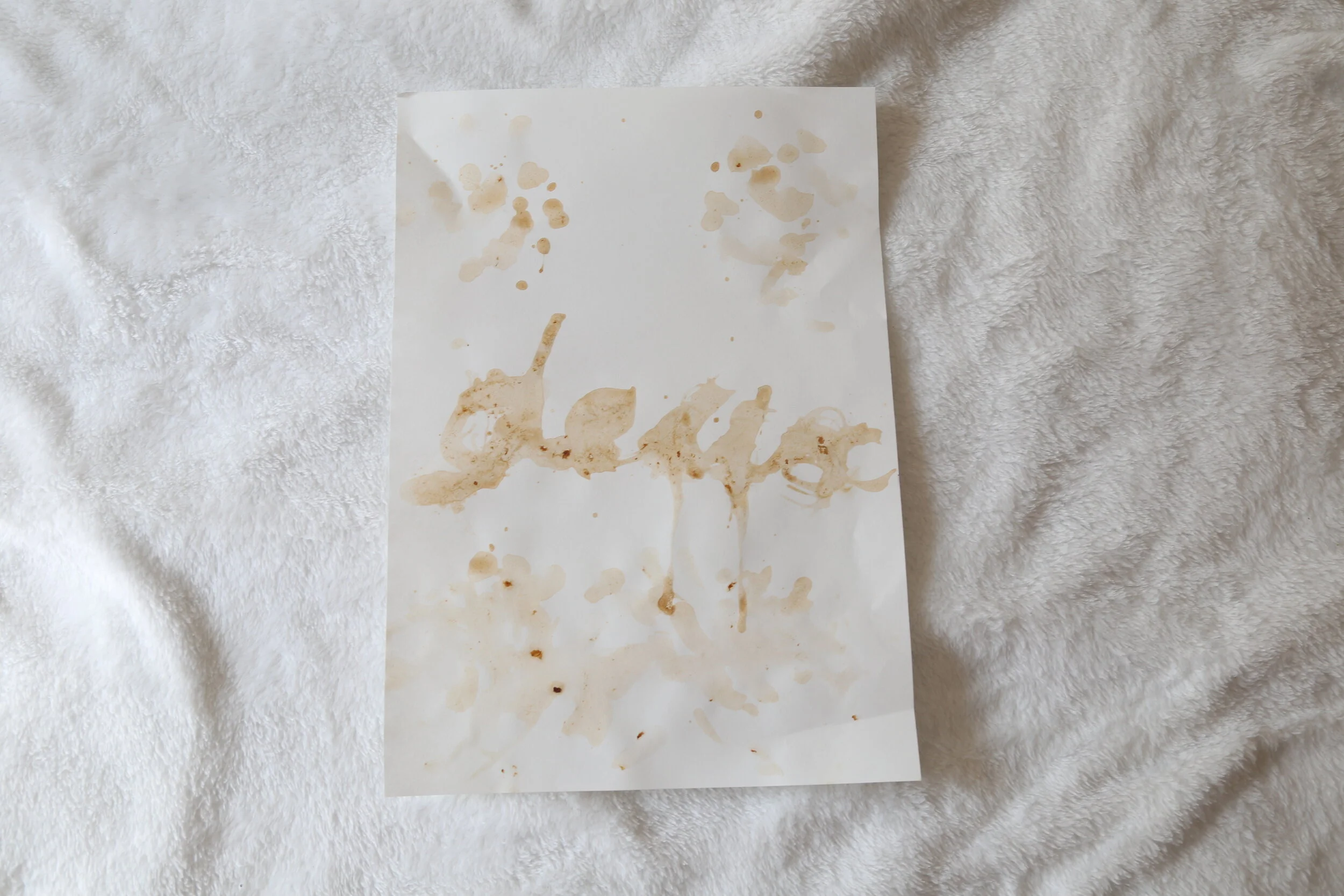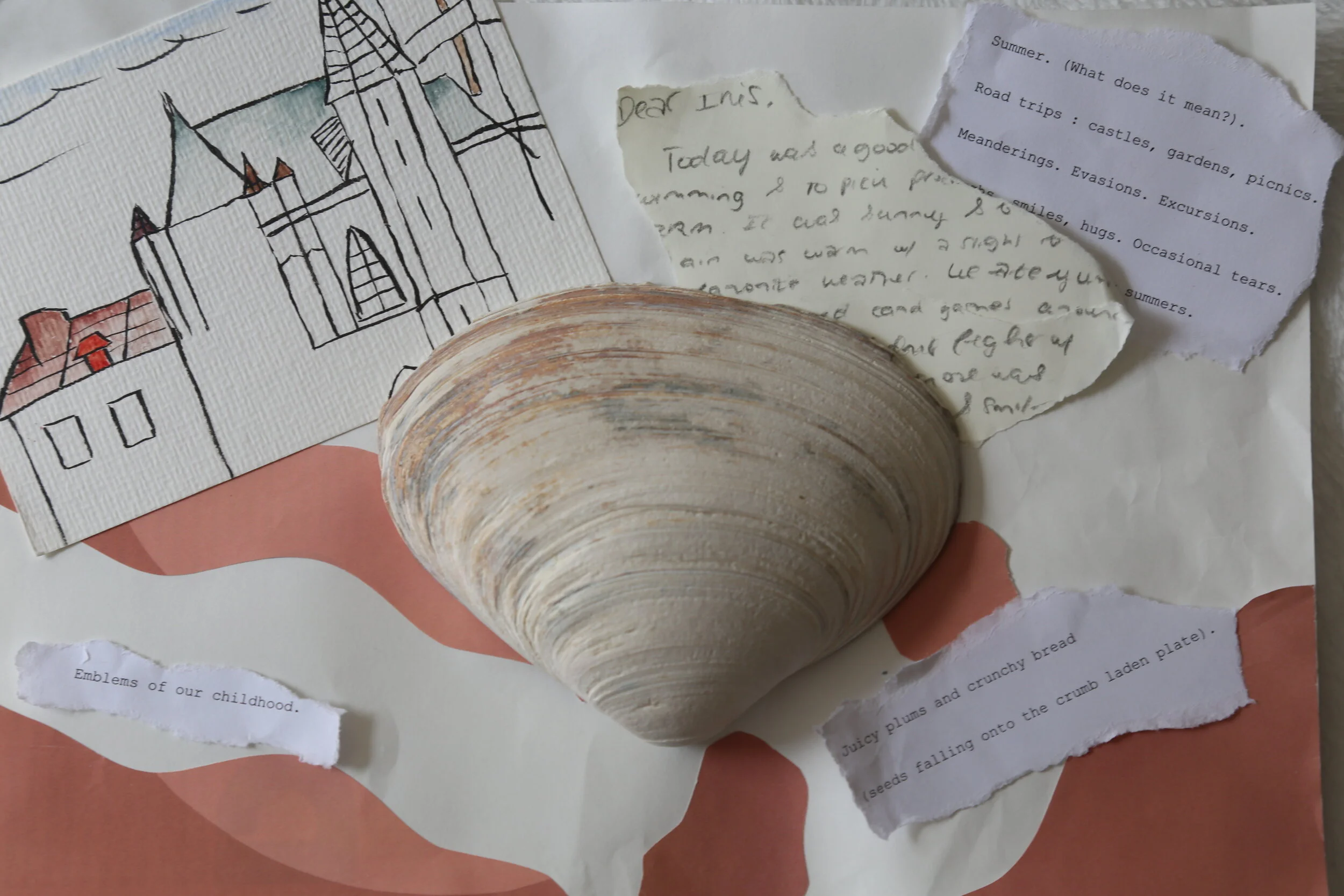Laundry List of Memories, 2019
mixed media triptych (peach juice on paper; ink and watercolor on watercolor paper; paper, watercolor paper, ink, graphite, and seashell on paper)
This was my first studio project at Parsons School of Design, created in my Integrative Studio class, focused on the theme is Memory.
Having only the guideline to create a piece based off of three memories, I made three vignettes of my memories using various media, in an attempt to engage the viewer and perhaps touch them on a personal level. The tissue that connects the three parts is not only the memories themselves, but also the feelings they procure: happiness, joy, and carefreeness – all exemplified in the atmosphere of summer.
We had the choice between creating three different pieces or one piece, but regardless there needed to be three memories evoked. I chose to make a triptych with each part corresponding to either one or several memories brought together as one.
The first vignette is inspired by an old video from when I was two years old and living in Florida. It depicts me in my underwear being held by my older sister as we were being interviewed by my dad. In the video, I seem to be desperately trying to release myself from my sister’s firm hold; I want to break free. My dad asks me how old I am and before I have time to collect my thoughts, my sister answers for me - bossy as she was. She continues to speak in my place until suddenly, somehow removing myself from her grip, I say, “J’ai deux ans”, meaning “I am two years old” in French. That moment has stayed with my family and I ever since. There is something about it that brings me joy; I was a tiny human being and yet there I was proudly affirming the fact that yes, indeed, I was two years old. Initially I wanted to use cherry juice to “paint” the word “deux”, because of many memories I have of my dad hand pitting cherries for me to eat as a snack, meticulously, one by one. It represents sweetness and nostalgia. However, after trying this out, the color appeared too dark and off-putting, almost like blood. It boldness did not help evoke that sense of lightness, innocence, and sweetness that I was aiming for, so I chose to use peach juice: I figured it would still maintain the connection with my childhood memories, albeit different from the cherry memory – the countless times I’ve bit into a peach only to have the juices drip down my wrist and onto my lap. The peach’s color better is much more subdued and whimsical, and therefore was a better fit for the vibe I was going for.
I decided to write out the number two in my native language French so as to maintain a sense of intimacy, of anonymity, of wonder – it is, after all, a deeply personal memory. Only those who know the language will be able to understand what it means. Even so, it is relatively easy to decipher its meaning ; my intention is not alienate those who do not speak the language, but by presenting a personal memory this way, perhaps the viewer will be invited to dig deep into their own repertoire to unlock some hidden memory. What is this “deux” messily written on the wall? I chose to use food to represent it because. I wanted to emulate that sense of purity, that feeling so reminiscent of a child – messily playing with their food, not knowing how to hold a paintbrush, smudging their clothes with some questionable substance. In essence, this my attempt to reconnect with that part of me that I have now lost because of time. That childlike quality that has slowly drifted away with age, maturity, and too much information, but that represents some of the happiest moments of my life.
I wrote in cursive form to reference this idea of flow, the flow of life moving – sometimes slowly but always forwards. The flow of the river that brings me close to home in Chicago. The flow of water, this fundamental element that sustains human life. As such, the word “deux” seems to rise from the flow, it appears as both a continuation and a disruption in the story of my life. It also reminds me of my elementary school years when we were required to write in cursive with a fountain pen. Those were good days.
The paper, too, is not anodyne. It is somewhat flawed, imperfect, just like a child’s actions are. As for the stains around the word, I think they speak for themselves. When creating this piece, I was not afraid to play with the peach ; I squeezed it, tore it, plucked the pit out of the flesh, like a child. It was a revel for the senses, my fingers were left stained with a warm orange pink hue, damp from the fruit’s juices, my mouth sweet with the taste of nostalgia.
But just as the word seems to flow seamlessly on the page, there also lies a feeling of uncertainty. As we discussed in our seminar class, Teju Cole in his essay Memories of Things Unseen, manages to convey uncertainty without failing to make a firm argument. He is certain in that he is uncertain. And that is powerful - and hard to achieve. So how does one do it through a visual piece? That is what I attempted to solve.
The second vignette is a collection of small scale drawings and pictures that once again reference my childhood. The pictures themselves are specific memories – picking a dandelions and enjoying the scenery around my family’s summer home. The drawings depict various locations I visit in my summers. The act of making each drawing is a memory in and of itself, which adds layers to the process of memory. The images also resemble postcards which are valuable vehicles to maintaing and transmitting memories.
I decided to hang these works from a wire to mimic hanging laundry. This is tied to another very distinct memory I have of watching my grandmother hang clothes to dry in the fresh summer air. If I had to paint a picture of my grandma it would be her, in her sunhat, hanging clothes, sipping ice water, or eating a watermelon. In this way, I blend the two places where I spend my summer in a visual way, which then leads to the last piece of the installation wherein I focus on the area where my grandma lives.
The third and final vignette is a collage of several mementos representing a fond memory I have of picking seashells at the sea with my aunt and grandma. They live in Normandy – a region known for its oysters – where hundreds, if not, thousands of seashells wash up on the shore all year round. Their beauty awes me: their shape – perfectly circular or jagged – their texture – smooth or rough – and their colors – subdued yet intricate. As such, I placed a seashell in the center of the composition as the focal point, and around, I included other elements reminiscent of Normandy: an excerpt of a poem I wrote entitled Summer, magazine paper which I cut out in undulating forms to mimic the waves of the sea, and a piece of paper from my journal. I wanted to juxtapose different materials to create contrast of textures and colors – the bold pastel pink from the magazine paper echoes the pink striations present on the seashell. The yellow toned journal paper with pencil handwriting stands out against the bright white printed paper with “typewriter” font. This piece – filled with contrasts – is a reminder of the contrasted person I am – and which I wrote about in my essay for Seminar 1. My life is defined by ambivalence and oppositions, which is something I am both proud and scared of. This collage can be understood as a representation of this duality.
The underlying theme that connects the components of this project is nostalgia and memory - nostalgia of memories, nostalgia for happier days, nostalgia for the sweet things – both literally and figuratively – and the simple pleasures of life. Nostalgia for summer. This piece is imbued with memory, but also with genuine joy and simplicity. It is my attempt to bring to life and emulate my childhood days – back when I was happy, carefree, and always smiling, before all the difficulties, stresses, and anxieties that are now present in my life. These recent years have been extremely difficult on a personal level, so this piece is a reminder that life still holds sweetness and pleasure.
Movement is another connecting tissue in this piece. It is expressed subliminally – through the wrinkles in the sheet, the performance aspect integrated in the first vignette – with the “deux” – the shapes of the paper cutouts in the collage, and even the way the wire dips as it hangs. It creates a certain flow, a continuous movement that binds the piece with its meaning. The movement also relates to this idea of mapping : mapping my memories, trying to remember them as best I can and bringing them to life. It is a metaphor wherein your eyes – and thus mind – travel through the various elements of the installation. This idea of mapping is more firmly represented in the wire that holds the pictures and drawings : there is a beginning point – point A – and an end – point B. Despite this explicit delineation, the piece remains fluid because the pieces are tied together through their story and visual similarities. I am a very conceptual person, therefore I struggle with translating my ideas and thoughts into tangible visual pieces. I toyed with various ways of presenting it before deciding to make a triptych. I think the simplicity I was able to convey is what makes it cohesive and effective as an installation. This piece was definitely challenging to create, but I am proud of how it turned out. It is a representation of my process. By emulating a sense of longing, this piece brings to the foreground the happier times of my life.








